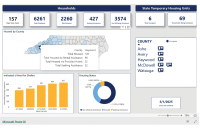Making the grade: Educator reinvents dropout prevention, but budget cuts jeopardize program
 Kyle Ledford spent years working with at-risk youth and high school dropouts in the Haywood school system. Saving kids was his calling, but it always felt like he was not playing with a full deck.
Kyle Ledford spent years working with at-risk youth and high school dropouts in the Haywood school system. Saving kids was his calling, but it always felt like he was not playing with a full deck.
SEE ALSO:
• Dropout program in jeopardy
• Caught in life’s crosshairs, students struggle not to dropout
• Trying to put a square peg in a round hole? Kyle Ledford’s your man
“The problems these kids were having could not be addressed in and of itself by a school. We couldn’t do anything about getting them a job or providing childcare or getting them housing and clothing,” Ledford said. “I can teach kids all day long, but I can’t do anything about housing and I can’t do anything about food stamps and I can’t do anything about transportation. The school system can’t solve a societal problem. It takes the community.”
Dropout program in jeopardy
 Despite wild success rescuing high school dropouts and turning their lives around, the Haywood Community Learning Center is on the brink of closing if a funding quandary isn’t solved soon.
Despite wild success rescuing high school dropouts and turning their lives around, the Haywood Community Learning Center is on the brink of closing if a funding quandary isn’t solved soon.
Caught in life’s crosshairs, students struggle not to dropout
 The trials of adulthood came early for Nicole Ferguson.
The trials of adulthood came early for Nicole Ferguson.
Haywood schools chart course for future
This fall, while Haywood County students are focused on homework, football, the opposite sex and the many other preoccupations of youth, their teachers and administrators are mapping a plan to make them more successful and competitive when they leave Haywood’s hallowed halls of learning.
2010 is a year for Long Range Strategic Planning in the school system, and if you gave only a cursory glance to the state of schools in North Carolina, you’d think they have their work cut out for them.
Haywood County Schools alone have seen $5.2 million in funding cuts since January 2009. Instead of increasing teacher assistants as planned, they are losing them left, right and center to lack of funding, struggling to keep hold of the 68 that remain. Meanwhile, the economy outside the school budget has worsened as well, and more than half of Haywood County students are now eligible for free or reduced lunch, a measure the school uses to gauge poverty levels among its students.
But Assistant Superintendent Bill Nolte said he doesn’t look at it like that. He knows that the increase in poverty and need among students and the decrease in funding is — and will continue to be — a challenge.
“We know our population is changing,” Nolte said “We know that our free and reduced lunch rate has changed about 10 percent in the last 11 years.”
But he’s also optimistic that the changes that have happened since the last long-range planning sessions in 2005 have not all been for the worse.
“The world really is different,” Nolte said. “I mean we’re changing at a very rapid rate. It’s just amazing. When these recommendations were made (in 2005) I had dialup at my house and could not get cable. I hope the (new) recommendations are different, because we don’t want recommendations for 2010, we want people to think about ‘OK, what’s it going to be like in 15 years or 17 years and what should we be striving for?’”
To do that, Nolte and his team have identified five areas they want to plan for, and then called on the community to help them map out the steps to get there in the long term.
The school system asked anyone who was interested — parents, community leaders, business people and just interested residents — to volunteer for committees that would spend anywhere from weeks to months suggesting what they think schools and students need to be doing in the future.
They try to stay within the state objectives and keep the school’s mission statement in mind, but Nolte said school administrators try to give the committees free-rein in dreaming up their recommendations, hoping to stir up innovation and creative thinking that wouldn’t happen under strictly-imposed guidelines.
But Knox Hardin, the school system’s testing director and co-chair of the committee tasked with producing globally competitive students, said that the state of affairs in the county, state and nation has put something of a damper on how far recommendations can go.
“Five years ago, we were not in the economic situation that we’re in now,” said Hardin, who co-chaired a similar committee during the 2005 planning process. “We have been asked to try and at least give half of our recommendations that we make that would not be dependent on funding. Five years ago, we could look pie-in-the-sky.”
Besides wholesale changes in the economy and the system’s funding base, this year’s plan will likely be vastly different from 2005 because the school system itself is moving in a new direction. Just over two years ago, the system adopted a new mission that places passion and productivity at the heart of all they do. And Nolte hopes that the committees will keep this in focus when they’re looking into the future.
“One of the things we talk to (the committees) about is as you’re developing recommendations, please remember our missions,” said Nolte. “Is this something we would fight for, lobby for, advocate for, spend for? Is it a productive way to do it? Does it promote student success in some objective measure that we have for students?”
Looking back at the 2005 recommendations, some did clearly fit those criteria. Out of 20 recommendations that the school system adopted, it only fully achieved nine, which included a major reduction in dropout rates, gym remodels at both Pisgah and Tuscola high schools, and beefing up technology education, both in quantity and quality.
Two of the recommendations — increase teacher assistants in grade K-3 and build an additional middle school — weren’t met at all. In fact, they actually lost teacher assistants and are struggling to keep the ones they have, although Nolte said this is simply a matter of money, or the lack of it.
Of the other nine goals, all were met partially, but to varying degrees. Some, like activity bus replacement, were halted with the budget drop. Others, such as computer, router and server replacement have been nearly met, with a good computer replacement cycle in place with only a lag in server replacement.
Still others, however, were sort-of met but lack a good bit before they could credibly be called successful. For example, the directive to provide staff development focusing on the Spanish-speaking population included only one summer “staff development” and a 30-minute refresher course, with a few “scheduled meetings” tacked on for good measure.
Hardin said that now, when the committees meet, they look back at these, assessing where they succeeded, where they failed and what failures should be tackled again.
“The ideal goal is to come up with suggestions that can help improve academic performance and have future-ready graduates that are ready to go into the workplace or ready to go into the next step beyond high school,” Hardin said. “We need to have our kids prepared to do the best at whatever they do when they leave school.”
Nolte echoes this sentiment, saying that he hopes the plan will provide a path towards making all of Haywood County’s schools better in what may continue to be very tough times.
“The recommendations are a real, tangible guiding beacon. They give real direction to your decision making,” said Nolte. “We really do believe that everything’s important. We really do believe that you’re not a great school system if you only do one or two things well and other things are really crummy.”





